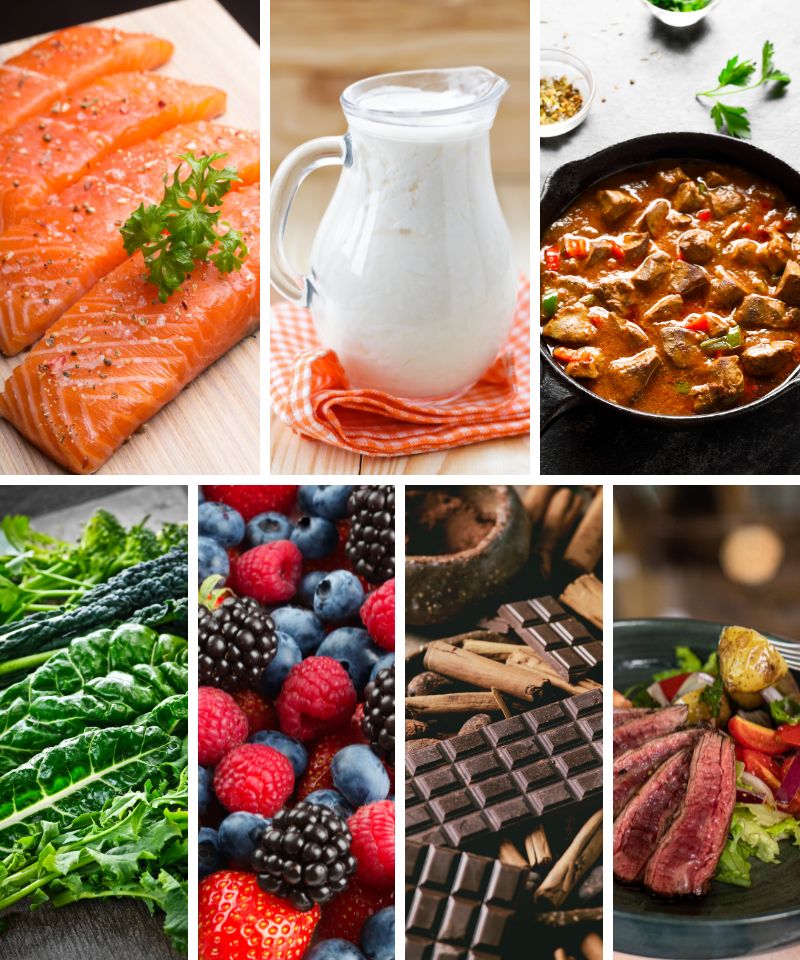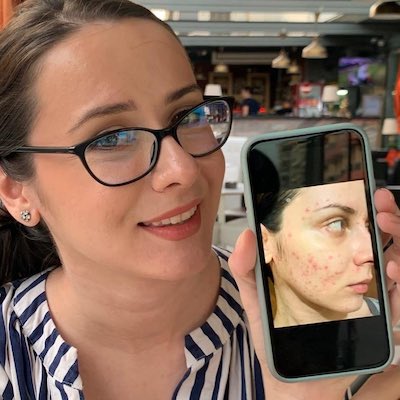It’s well known that certain foods can increase the already excess amount of oil production, which can aggravate inflammatory skin conditions such as acne.
Therefore, by avoiding certain foods and replacing them with healthier alternatives, you will notice a significant improvement in controlling your oily skin and pesky pimples.
Here are ten foods to avoid if you have oily, acne-prone skin:
- Dairy.
- Sugar.
- Gluten and carbohydrates.
- Refined grains.
- Chocolate.
- Greasy and fried foods.
- Nuts.
- Alcohol.
- Food additives and preservatives.
- Caffeine.

#1 Dairy
Dairy is one of the main acne triggers that’s particularly problematic for individuals with a predisposition to developing the inflammatory skin condition and those who are sensitive to components found in dairy, such as whey, a protein found in the liquid part of milk that remains after the milk curdles, and is usually present in all types of dairy products.
Dairy has long been a topic of debate among professionals when it comes to how exactly it can cause acne; however, some studies suggest that dairy products contain large amounts of the hormones IGF-1 and estrogen, both of which have been linked to acne, especially when they’re not in balance with other hormones such as androgens and progesterone.
An imbalance between the female hormones estrogen and progesterone can influence skin oil production by allowing an increase in androgens (male hormones), which can stimulate excess oil production and lead to acne.
This happens because the oil-producing glands contain androgen receptors within them, and when they are imbalanced, they will signal to the glands to produce excess oil to try and maintain homeostasis, a state of balance within the body.
Additionally, both estrogen and progesterone can also affect the life cycle of skin cells, and an imbalance between these hormones can cause an overproduction of skin cells, which end up getting stuck inside the pores, clogging them, and eventually leading to inflammation and acne.
Finally, some of the problematic proteins in dairy have also been linked to the disruption of the gut lining and subsequent microbial imbalance and inflammation that eventually manifests on the skin as inflammatory conditions such as acne.
Therefore, while there are multiple theories and explanations about how dairy can cause acne, this particular issue may stem from various reasons for different people.
Some may be sensitive to a particular component in dairy, and this sensitivity manifests as an inflammatory skin condition, while others may be experiencing hormonal imbalance due to the presence of hormones in dairy products, which eventually results in oily skin and acne.
This is why those dealing with acne are frequently advised to reduce or completely cut out dairy consumption to help manage their skin condition.
#2 Sugar
Second on the list after dairy, sugar is another one of the highest acne triggers that should be avoided by those who are dealing with or are prone to acne, as it can cause or worsen this inflammatory condition in many cases.
The primary concern with sugar is its ability to cause a sudden spike in blood sugar levels, which leads to an increase in insulin, a hormone released by the pancreas.
When insulin rises, our bodies then produce other hormones, such as IGF-1 and androgens, which will trigger the oil glands in the skin to produce more oil to achieve homeostasis due to the sudden spike in insulin.
This leads to excessively oily skin, further exacerbated by increased blood sugar levels that causes inflammation.
Additionally, sugar is also known to be pro-inflammatory, as it triggers a response from our immune system, thus increasing inflammation throughout the body, which may eventually manifest on the skin in the form of inflammatory conditions such as acne.
#3 Gluten & Carbohydrates
Another high-glycemic food source to avoid for oily skin is gluten and carbohydrates, such as wheat, rye, barley, and oats.
Carbohydrates have been linked with increased inflammation in the body, and numerous studies have also linked these components to acne.
Consuming gluten and foods rich in carbohydrates can cause a rapid increase in blood sugar levels and trigger or worsen existing acne due to causing insulin levels to rise in order to control the spikes caused by these foods.
This leads to an increase in the activity of certain hormones, which stimulate the oil-producing glands, resulting in increased oil production and acne as a consequence.
Additionally, gluten can also be too harsh for the body to process, leading to damage to the gut lining and subsequent permeability.
Gut permeability means the gut wall becomes porous, allowing bacteria, toxins, particles, and proteins to pass through the gut wall into our bloodstream, leading to an immune response and inflammation.
And since our skin receives nutrients and oxygen from the blood, it will inevitably suffer from any inflammation caused in the gut.
However, while it’s important to note that gluten and carbohydrates may not always cause acne for everyone, those prone to this skin condition should consider reducing or cutting out the consumption of the inflammatory particles and monitoring their skin for any improvements.
#4 Refined Grains
Refined flour loses fiber, minerals, antioxidants, and other important carbs, fats, proteins, and vitamins during processing.
This leaves the final product without nutritional value and a high glycemic index, which can quickly spike your blood sugar and insulin levels.
These spikes will then cause inflammation in the body, leading to hormonal imbalances that result in the overproduction of oil and acne.
#5 Nuts
Some nuts can be problematic for those with acne-prone skin due to the high content of pro-inflammatory components such as omega-6 fatty acids.
Omega-6 fatty acids are a precursor to the production of prostaglandins and leukotrienes, which are inflammatory molecules part of the immune system’s defense that become active when trauma, such as an injury or infection, occurs.
Prostaglandins and leukotrienes play essential roles in several physiological processes, including blood clotting, regulation of blood pressure, and increased mucus production, which are responses to various injuries.
However, while prostaglandins and leukotrienes play essential roles in the body’s immune response, excessive production of these molecules can lead to chronic inflammation and contribute to various health problems and inflammatory skin conditions, such as acne.
Therefore, try to avoid nuts that have a high omega-6 content, such as cashews, walnuts, pistachios, and peanuts, and opt for nuts and seeds with a higher omega-3 content, such as almonds, hazelnuts, and chestnuts.
#6 Greasy & Fried Foods
Greasy and fried foods can also contribute to the development of acne due to being high in unhealthy fats, such as saturated and trans fats.
Trans fats, in particular, are predominantly found in margarine, fried fast-food, shop-bought baked goods, some microwave popcorn, packaged snacks, vegetable shortening, ready-to-use dough, and coffee creamers (both dairy and non-dairy) and are one of the unhealthiest fats you can consume.
They’re created when manufacturers treat vegetable oils with a process called hydrogenation, which gives the oils a longer shelf life and makes them more solid at room temperature.
But this process also changes the chemical structure of the fats, and as a result, they become more difficult for our bodies to break down.
Trans fats have been shown to increase the risk of heart disease, stroke, and type 2 diabetes, and they can also contribute to inflammation by increasing the production of inflammatory molecules, such as cytokines, eicosanoids, and interleukin-6 (IL-6), which are produced by the immune system in response to injury and infections to help promote healing and fight off pathogens.
Therefore, throwing your body into a perpetual state of inflammation can eventually lead to signs on the outside in the form of inflammatory skin conditions such as acne.
#7 Chocolate
Chocolate contains not one but three major acne triggers, including dairy, sugar, and nuts, which can be problematic for some people due to having an imbalanced ratio of omega-3 and omega-6 fatty acids.
Therefore, it’s best to avoid or limit the consumption of chocolate for clear skin and a healthier-looking complexion in general, as all of these ingredients can lead to perpetual inflammation in the body and not only wreck your skin but also cause serious health issues in the long run.
#8 Food Additives
Certain food additives, such as corn syrup, artificial food colorings and sweeteners, preservatives, soy derivatives, etc., can also promote excess oil production and trigger inflammatory skin conditions, such as acne, by causing spikes in insulin levels, allergic reactions and sensitivities, skin irritations, and hormonal imbalances.
For example, artificial food colorings, especially Yellow No. 5 and Red No. 40, which are derived from coal tar and are found in almost all processed foods, have been shown to increase the risk of allergies, food intolerances, and inflammation in the body, which can potentially manifest as acne on the skin.
On the other hand, preservatives, such as sodium benzoate and potassium sorbate, which are added to foods to extend their shelf life, can be too harsh for many people’s bodies to process, leading to inflammation and skin reactions.
Finally, soy derivatives, such as soybean oil and soy protein, are found in various processed foods and contain high levels of omega-6 fatty acids, which promote inflammation in the body and are one of the highest contributors to inflammatory skin conditions, such as acne.
Therefore, while it’s impossible to eliminate all food additives from your diet, it’s wise to try limiting the consumption of foods with these additives as much as possible when dealing with excessively oily and acne-prone skin.
#9 Caffeine
While not technically food, caffeine is a huge part of what many of us consume daily and something that doesn’t do you any favor when trying to control excessively oily skin and acne.
Caffeine is a mild diuretic, which means it makes your body excrete more fluid, which can sometimes lead to dehydration.
Long-term dehydration triggers certain hormones, such as cortisol and androgens, to stimulate the oil glands to produce more oil to compensate for the lack of water or moisture.
This will oftentimes result in an overproduction of oil, which can lead to clogged pores and breakouts.
Therefore, while it’s certainly not necessary to eliminate caffeine from your diet altogether if you’re struggling with oily skin and acne-prone skin, it is a good idea to try and reduce the intake of caffeine-containing beverages while also increasing your intake of water throughout the day.
#10 Alcohol
Similarly to caffeine, alcohol is a diuretic, which means it can dehydrate you. And as we already discussed, dehydration can lead to excessive oil production and contribute to breakouts.
Alcohol is also high in sugar, which not only disrupts your hormones but can also increase internal and external inflammation.
Finally, alcohol is a vasodilator that expands your blood vessels, leading to increased blood flow, which can cause your skin to become overly red and inflamed.
Therefore, it’s best to avoid alcohol if you’re trying to achieve a clear complexion or at least limit your consumption to special occasions.
The Best Foods to Eat if You Have Oily/Acne-Prone Skin

Eliminating certain foods from your diet is only half the battle when it comes to achieving a clear complexion.
To make sure you get all the nutrients and vitamins necessary for healthy skin, it’s important to incorporate certain foods into your daily menu that have been shown to help reduce inflammation, improve skin tone and texture, and prevent excess oil production.
These include:
Fatty Fish
Salmon, mackerel, herring, sardines, and anchovies can provide your body with essential omega-3 fatty acids, which can help strengthen the skin barrier and improve its ability to fight off pathogenic bacteria, as well as reduce inflammation in the body that has led to acne.
Kefir
A fantastic probiotic, kefir can help encourage the growth of good bacteria in the body, improving gut health and reducing inflammation, ultimately leading to healthier-looking skin.
Chicken Liver
Besides being an excellent source of vitamin A that can help those struggling with acne, chicken liver is also packed with selenium, an anti-inflammatory mineral many of those taking medications such as birth control to control acne are deficient in.
Leafy Greens
Many leafy greens, including broccoli, cabbage, and celery, are fantastic sources of vitamin A that can not only help minimize inflammation in the body but can also encourage healthy cell formation and renewal, promoting shedding and revealing a clearer and healthier complexion.
Berries
Blueberries, blackberries, and raspberries are rich in antioxidants, which stimulate the action of enzymes that help repair cell damage and promote cellular turnover, improving skin radiance and reducing inflammation.
Dark Chocolate
Unlike milk chocolate, which can cause inflammation, dark chocolate is a much healthier alternative packed with flavonoids, a type of antioxidant that helps prevent cellular damage, thus improving overall skin health and reducing inflammation caused by free radicals in foods containing artificial and inflammatory ingredients.
Dark chocolate is also dairy-free and contains less sugar than milk chocolate.
For comparison, dark chocolate with 70-85% cocoa has only 7g of sugar, while average milk chocolate has up to 52g of sugar per 100g.
Healthy Fats
Mono and polyunsaturated fats from sources like olive oil, fish, meat, some nuts, and seeds can help nourish the skin, soothe inflammation, and reduce the overproduction of oil on the skin.
Lifestyle Factors That Help Control Oily & Acne-Prone Skin

In addition to avoiding the foods above and incorporating healthier alternatives into our daily menu, certain lifestyle factors can also help control excessively oily and acne-prone skin.
Sleep
Getting enough sleep is essential for a clear, healthy complexion, as our skin cells need rest to regenerate after a long day of being bombarded with environmental pollutants, free radicals, UV rays, and other damaging particles that attack vital parts of their DNA.
Additionally, getting enough sleep can also help reduce the overproduction of oil by reducing the activity of cortisol, also known as the stress hormone, that happens to be involved in stimulating the oil-producing glands.
Therefore, getting enough sleep can help keep oily, acne-prone skin at bay and give you a glowing complexion.
Stress Management
Stress can truly do a number on your skin, and acne is one of the main side effects of being in a constant state of stress and discomfort.
This is because when we are stressed, the hormones that are released put the body into a “fight or flight” mode, and evolutionary this means more oil production, as our skin oil is produced to protect from the outside elements.
Additionally, when we are stressed, we often tend to touch our faces as a defense or soothing mechanism, which can only add to the buildup of bacteria and oil on the skin and lead to infections and acne.
Finally, excessive stress depletes energy—physically, mentally, and emotionally, and this can often make us uninterested or too tired to do our skincare routines or even remove our makeup before going to bed, which can have disastrous effects on oily, acne-prone skin.
Therefore, it’s essential to find ways to manage stress, whether that’s by taking a few minutes out of your day to meditate or practice yoga, go for a walk, play your favorite sport, or even spend time in silence with your own thoughts, as this can not only help improve your mental health and wellbeing but can quite literally help clear up your complexion.
Exercise
Exercising might not sound like something that would clear up your skin, but it very well may, thanks to promoting circulation, which can help oxygen and other vital nutrients reach the skin cells, allowing them to regenerate faster and revealing a brighter and clearer complexion.
Exercising will also drive insulin down, and levels will normalize while keeping cortisol in check, which are two major inflammatory hormones that can trigger or exacerbate acne for many people.
Additionally, exercise also promotes lymphatic movement, which is a secondary circulatory system in charge of clearing away toxins accumulated in our bodies from inflammatory foods, cosmetics, and artificial hormones found in some medicine, such as the birth control pill, which will help promote a clear and healthy complexion.
Finally, exercising for at least thirty minutes a day has been proven to release endorphins, often referred to as the happy hormone, and this can help reduce stress levels, also leading to a clearer complexion.
Drinking Water
While drinking a lot of water won’t directly clear up your skin, it will help your body filter out components such as bacteria, viruses, artificial hormones, and certain chemicals in cosmetic products that can find their way into our bloodstream and lymph nodes and can create a lot of damage for our cells, which could lead to imbalanced hormones, inflammation, and acne.
So, while there isn’t a study directly relating drinking water to clearer skin, it certainly serves a great purpose in improving our overall health and well-being, so it’s definitely worth incorporating into your routine.
Drinking water can also help keep oily skin in check by minimizing androgen overactivity and subsequent overproduction of oil, which often results from the body trying to compensate for the lack of moisture.
Skincare Routine
Finally, having a complete routine that consists of a gentle face wash, an exfoliating solution, a moisturizer, and sunscreen to keep the skin barrier healthy and hydrated will help balance oil production and keep oily skin in check while minimizing inflammation and reducing the appearance of acne.

PS: Tired of struggling with acne-prone skin and feeling self-conscious about your complexion?
My brand new course, “The Acne Solution,” is here to help.
With expert guidance and proven strategies, you’ll learn how to banish breakouts for good and achieve the clear, radiant skin you deserve.
This comprehensive step-by-step program covers everything from skincare routines to diet and lifestyle changes, so you can tackle acne from all angles.
Say goodbye to the frustration and embarrassment of acne and hello to a confident, glowing you.
Sign up for “The Acne Solution” today and start your journey to clear skin.

My name is Simone and I am a certified skin specialist. I created this website to teach my readers how to take great care of their skin and I also like to occasionally share my honest opinions on skincare products I’ve tried. You can learn more about me here.
